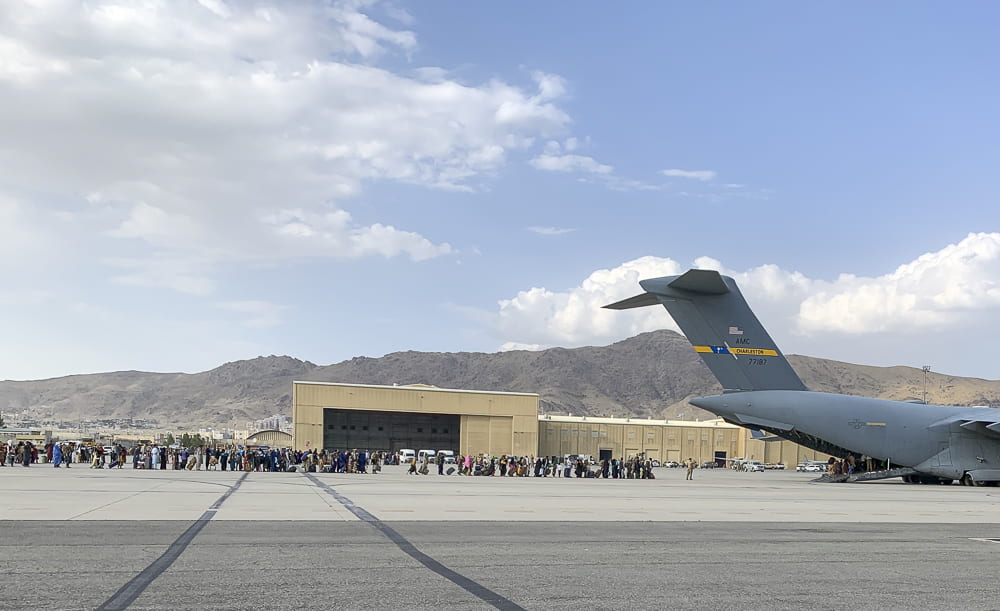When US troops began leaving Afghanistan after 20 years of military involvement, questions emerged about what the withdrawal would mean for stability and security in the region. One principal question was: What happens to the thousands of Afghan citizens who risked their own safety and the safety of their families to assist the United States’ mission? These individuals, who worked as translators, drivers, independent contractors, and other aid to the U.S. mission, were targeted by the Taliban because of their association with the United States. Their main pathway out of Afghanistan was through the Special Immigrant Visa program (SIV).
What is the SIV program?
In 2009 , Congress created the Special Visa Program (SIV) as a unique pathway to citizenship for Afghan nationals who directly assisted US and NATO forces. Since 2014, roughly 16,000 applicants have received SIVs. There are currently over 18,000 Afghans with pending applications.
Getting an SIV:
In order to obtain a typical SIV, an applicant must check-off certain requirements and go through a long journey of bureaucratic red tape. First, the applicant must receive a reference from a US agency, NGO, or media organization to verify that they assisted the U.S. for at least two years. Once they have submitted this application, they will be notified by email that their application is being processed, at which point they will have to find a way out of Afghanistan to a third country where they will wait for their application to be processed. Getting out of landlocked Afghanistan before the Taliban takeover was extremely challenging. Typically an applicant would attempt to enter neighboring Pakistan, make their way to Turkey, or American territories like Guam where they would wait anywhere from one year to 20 months for their application to be processed. After the application has been processed, the applicant is interviewed by a US consular officer. These interviews must take place at a US embassy or consulate. After navigating all of these steps, the visa applicant may have their visa approved and resettle in the United States. Another hurdle to seeking protection through the SIV program is that applicants may only bring their spouse and children under 21 years old with them to the US. This means an SIV recipient would have to make the hard decision to leave behind any parents, siblings, adult children, or other family behind where their lives will likely continue to be threatened.
As US troops leave Afghanistan, they also leave US allies to rely on a process that is only available to a small percentage of those in need, takes years, and does not provide for safety measures in the interim period.
The attempt to ramp up SIV evacuations:
A growing outcry from Afghans and allies forced the Biden administration to help evacuate some SIV applicants directly to the United States. In July, 2,500 Afghan applicants who had completed almost all of the SIV process were brought to Fort Lee, Virginia to await the final stages of processing. Additionally, the SIV program was expanded to allow a larger pool of people to apply under a new “Priority 2” designation. Priority 2 applies to Afghan nationals who either did not meet the minimum 2 years of service requirement, but still assisted the US directly or indirectly through US based NGOs, media organizations, or contractors. During the scramble in late August to evacuate as many people as possible, the Biden administration pleaded with allies to accept applicants while their paperwork was processed, thus ensuring their safety during their processing period. By assisting some families in safely reaching the United States or third countries, and expanding the range of people who can apply, the US government took some necessary steps to uphold its most basic obligations to those who assisted in its military mission. However, these steps should have been taken sooner to prevent chaos and violence. For example, the pleas to other nations to accept refugees was too little too late, when thousands of SIV applicants were already unable to get to Kabul to escape the country due to the Taliban’s swift take over. The Biden administration knew it was withdrawing troops and knew the US’s Afghan allies would be targeted. The administration will have to answer for why these measures to evacuate allies were not taken sooner.
Legal accountability for SIV shortcomings:
Additionally, the Biden administration faces legal pressure to do more for those who worked as allies in conflict zones. A class of Afghan and Iraqi applicants sued Secretary of State Anthony Blinken, the Department of Homeland Security, and the Department of State for allegedly delaying their applications an unreasonable amount of time. Based on the finding that more than 7,700 applicants had been waiting over 9 months, the maximum set by Congress’ mandate, the D.C. District Court declared the delays unlawful. The Court found the delays were unreasonable and adopted a Joint Adjudication Plan to ensure the SIV process runs more efficiently, and require the government departments to submit quarterly updates to the Court. The government is currently in the process of appealing this decision to the US Court of Appeals of the District of Colombia Circuit.
These changes of expanding the SIV program and holding the government accountable for ensuring the process run as efficiently as possible are important steps, but more can and must be done if the US wants to ensure the safety of its allies.
Author Biography: Meredith Gusky is a 2L at the George Washington University Law School and is pursuing her masters in International Affairs at the George Washington University’s Elliott School. This is Meredith’s second year as a Senior Moderator for ILPB, and she is excited to continue researching and learning about international law and politics with her fellow students.

